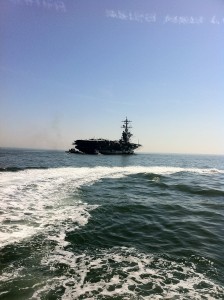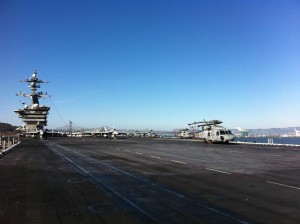The USS Carl Vinson rocks!
Let me start by saying that I am way too grown-up to say that something “rocks.” Mine is a more dignified vocabulary. Nevertheless, saying that the USS Carl Vinson rocks is the right way to start this post, because I want to discuss my visit to the USS Carl Vinson in the context of America’s youth and, in an ironic, self-referential way, my own youth. Before I get too deep, though, let me start with a linear narrative about my day, one that I’ll make more than usually girly and detail-free to ensure that I don’t inadvertently say something that is better left unsaid about an important ship that has secrets to keep.
It was sheer dumb luck that my kids and I got to enjoy an extraordinary day aboard the Carl Vinson. When the Navy League asked for ships’ greeters, I readily volunteered my services. The Navy League tries to have a greeter for every ship. The greeter’s job is to go on board, welcome the ship to the port (San Francisco, in this case), and to hand over a wonderful collection of coupons, maps, lists of free services, etc., all with the aim of making the visit as easy and enjoyable as possible for the men and women aboard the ship. From my point of view, it’s a sinecure. Navy League representatives gather all informational materials and coupons, bring it to the piers, and arrange clearance for us. All we have to do is show up and be welcoming.
This year, unlike past years, I was assigned (along with a couple of other Navy League members) to a ship that was anchored in the Bay and that would not be open for visitors. I had no assurance, therefore, that I would get on the ship. When I got permission to bring the kids with me, we were told that it was up to the ship whether to take us on board. I warned the kids that there was about a 50% chance we wouldn’t get on, and made alternate plans, just in case. I was a little more optimistic when the senior Navy Leaguer assigned to visit the Carl Vinson told me that we’d be boarding with the ship’s original Captain, Richard Martin. I still didn’t allow myself to get my (or my kids’) hopes up too high. After all, they might have whisked Captain Martin on board, and left us standing pier-side, waving good-bye. All I can say is that I did the Navy a disservice in assuming that it would behave so ungraciously.
Things were a bit slow in the morning, and we waited on the pier longer than expected, which was all to the good. While my kids were restless, I got the opportunity to meet Captain Martin; his lovely and charming wife, Anne; his delightful friends; and the other Navy League people hoping to go aboard. As I say every year around this time, Navy people are nice people: well mannered, welcoming and so enthusiastic about all things Navy. By the time the boat arrived to take Captain Martin, and his family and friends, to the Carl Vinson, there was no question but that we Navy League people would be going there too.
One of the things I always tell my children is that, while I haven’t done anything very interesting with my life, I’ve had the singular good fortune to know interesting people. In this case, a mere half hour before visiting the Carl Vinson, luck smiled on me and the children, and put us in Captain Martin’s friendly orbit. He was accorded the most splendid welcome you can imagine when he boarded the ship — and, listening to the stories he and others had to tell, I can understand why. This is where I interrupt my linear narrative and get to the point about my own youth.
I was a child of the 1960s and 1970s and, more than that, I was a child of San Francisco and Berkeley. I knew the drill: the Cold War was a farce, we Americans were bullies, the Russians were people just like us, U.S. imperialism blah blah blah, yadda, yadda, yadda. With age and experience, I’ve mercifully been blessed with some wisdom, and I’ve learned that the Cold War was not a farce, but was an existential battle between freedom and tyranny; that America was not a bully, but kept as many nations as possible on the side of liberty; and that, while the average Russian Vlad on the street might have been a person just like us, the Soviet leadership was dedicated to putting as many people as possible under the Communist yoke.
The actual facts (not the San Francisco/Berkeley filtered facts) meant that there was nothing cold about the Cold War. Instead, it was a deadly, and perpetual, cat and mouse game. While we, snug on our college campuses, sneered at the military, our military fought on the front lines, constantly tweaking the Soviet cat, all the while avoiding a direct confrontation. Captain Martin, as the first captain of one of ten Nimitz class super carriers, was one of the leading-edge warriors in this fight. The responsibilities he bore were enormous. While we now engage our enemies on the ground, in those days, the water was a major battlefield in this covert war, and he shepherded one of our biggest weapons.
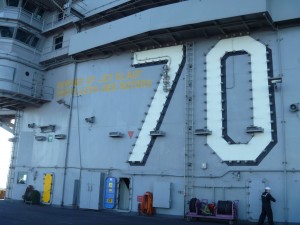
Bottom line, when it comes to the USS Carl Vinson’s intersection with my own youth: I was an ignorant, thoughtless child, who inadvertently gave aid to the enemy simply by refusing to recognize that there was an enemy. I was fortunate enough, though, to be protected by people who recognized the stakes in this existential war, and who put themselves on the front line. Lucky, lucky me. And now back to today’s story….
The USS Carl Vinson isn’t a ship that exists only in a glorious Cold War past. It remains a vital part of America’s arsenal, and its vitality is apparent from the moment one steps on board. To start with, the ship is huge. The total crew numbers almost 6,000 men and women (a number that includes the air wing). Because the ship is not open to the public, we walked onto a ship churning with activity, as sailors and Marines, all of them so very young, lined up for liberty. To the kids’ (and, yes, my) delight, since we were trailing in the wake of the ship’s top officers, hundreds of them fell silent and stood at attention as we walked by. For a modern civilian, it’s impressive, to say the least, to witness young people showing this kind of respect to those who, by virtue of age, effort and wisdom, have achieved a high status within an organization.
In no time at all, we found ourselves in the Captain’s quarters. A lovely and welcome repast was spread on the table in the stateroom (I think it was the stateroom), and Capt. Bruce Lindsey urged us to eat. I’m embarrassed to say that my kids alone probably gobbled up a quarter of the food before I realized what they were doing, but I’m not surprised that they did. Aside from the fact that they were hungry (as it took quite a while for us to board the ship), the sandwiches were delicious and the cookies were outstanding.
As we ate, Captain Lindsay gave us a brief and entertaining talk about the ship’s history: about Carl Vinson himself, a man whose life spanned most of the 20th Century, and who deserves enormous credit for giving us a Navy in the 1930s that was able to help us win a war in the 1940s; about the ship’s missions, including its stellar humanitarian work in Haiti; and about the ship’s crew, a collection of dynamic, hard-working, deeply committed young people who work extraordinarily hard on a ship that has virtually no down-time.
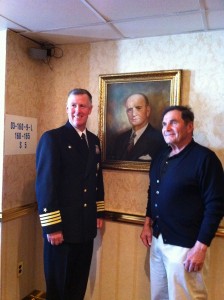
Captain Martin then spoke briefly about his years aboard the ship. He’s a very humble man, despite his high accomplishments. It says much about him that one of the things he’s most proud of is that he got the ship seaworthy 30 days early and $200,000,000 under budget. I don’t think things like that happen anymore in today’s world.
After the Captain’s spoke, and after our Navy League representative gave a short, sweet speech welcoming the ship to our fair City, and delivering a painting of the ship coming into the Bay, all of us were offered a tour of the ship. Yes! Oh, yes! But first we needed a pit stop. Captain Lindsay was gracious enough to allow us to use the restroom (uh, sorry, Navy types: head) in his own quarters. My son was impressed. When he emerged, he couldn’t contain himself: “That’s a really captainy-y bathroom!”
From the Captain’s quarters, we headed to the bridge, from the bridge to the flight deck, from the flight deck to the Admiral’s briefing room, from the briefing room to the Com. room, and on and on. I’m not telling what I saw in any detail, in part because I’ll get it wrong, and in part because I don’t want to say anything that I shouldn’t. I will say, thought, that it was all fascinating and that the crew members we ran into on this tour were helpful, informative, and had such nice manners. The ship was also in true ship shape, which is a pleasure to the eye.
Oh — about that crew. They are young. Just eyeballing them, my guess is that about 70% of those 6,000 crew members are 25 or under. What amazed me was learning that the person on the bridge handling the rudder (that is, steering this vast, nuclear powered ship) is probably 19 years old. Think about that: three years ago, he (or she) was getting a driver’s license; now she (or he) is driving a very big ship.
It’s obvious that our Navy has a tremendous respect for young people. It believes that they are capable. It believes that they are intelligent. It believes that, given the opportunity, they will act responsibly. It doesn’t coddle them. It doesn’t flatter them with false praise. It demands of them their best, and they dig into themselves and discover that they can meet that demand. These kids are America’s best and brightest because they willingly serve a harsh, but fair, task master, they grow up quickly, and they have the tools to become exemplary citizens, whatever they choose to do with their post-Navy lives.
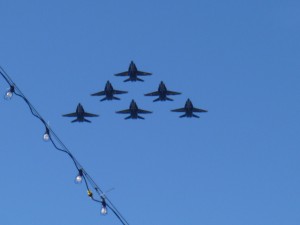
I want to keep this post away from politics, but I couldn’t help but contrast the young people I saw on board the USS Carl Vinson with these young people. I’ll say no more.
All it all, it was as lovely a day as one could wish. The weather was perfect, the people were delightful, and the ship was gorgeous (and surprisingly elegant, for such a utilitarian piece of equipment). Speaking of my own family, I can say without hesitation that a good time was had by all!
By the way, I’m not the only one who saw a contrast between the military and Occupy Wall Street. While I observed the two different types of young people drawn to the two different types of activities, Zombie noted that the military was, hands down, the audience favorite.
